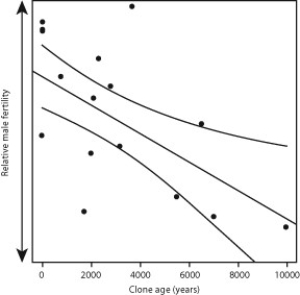Plants differ from many animals because they undergo indeterminate (continual) growth. Indeterminate growth is common in clonal plants because a single clone can continually produce new clones without undergoing sexual reproduction, even if the plant is capable of doing so.
Senescence, an inability to undergo cell division as an organism ages, also occurs in many plants and animals. However, scientists have had a difficult time establishing the occurrence of senescence in cloning plants because of their indeterminate growth patterns. Mutations in somatic cells are common during asexual growth, and these mutations lead to a decrease in sexual fitness. Scientists hypothesize that over time, as these mutations accumulate, they may contribute to senescence in clonal plants. To test this theory, scientists studied a naturally growing population of trembling aspen (Populus tremuloides) , a tree species that grows clones from its root system but is capable of sexual reproduction. To determine if trembling aspens senesce, they compared genetic data of estimated tree age with the variable of "diminishing fertility": the amount of pollen released by male aspen trees. Here are the results for this part of the study:
 Source: Adapted from Ally, D., Ritland, K., & Otto, S. P. (2010) . Aging in a long-lived clonal tree. PLoS Biol, 8(8) : e1000454. doi:10.1371/journal.pbio.1000454.
Source: Adapted from Ally, D., Ritland, K., & Otto, S. P. (2010) . Aging in a long-lived clonal tree. PLoS Biol, 8(8) : e1000454. doi:10.1371/journal.pbio.1000454.
-What can the scientists conclude from the data?
Definitions:
Concrete Operational
A stage in Piaget's theory of cognitive development, occurring from about 7 to 12 years of age, where children gain the ability to think logically about concrete events.
Formal Operational
The stage in Piaget's theory of cognitive development where individuals are able to think abstractly, logically, and systematically.
Preoperational
A stage in Jean Piaget's theory of cognitive development, where children from 2 to 7 years old develop memory and imagination, but do not yet think logically.
Nurture
The influence of external factors like environment, education, and social experiences on the development of an individual.
Q3: The most worrisome results of the large-scale
Q13: Within an ecosystem, a tree is a<br>A)
Q30: What is the best description of the
Q32: You lose track of your friend in
Q40: A sophisticated mechanism that has evolved in
Q44: Foreign genes can be inserted into a
Q52: In this marine community, the sea otter
Q57: The semicircular canals<br>A) are arranged in three
Q58: A single steroid hormone can cause different
Q65: If you lay your forearm along a